The TAXI Method: Reducing Fabric Waste with Recognizable Silhouettes in Sustainable Women’s Clothing
Abstract
:1. Introduction
2. Materials and Methods
3. Results and Discussion
3.1. “T” and “X” Basic Silhouettes of Women’s Dresses Modeled According to Existing Basic Clothing Construction (BCC)
3.2. Constructing the Basic Cut of the “T” and “X” Dress Silhouette of a Women’s Dress According to the Proposed TAXI Method (TM-BC)
3.2.1. Construction Method for the Basic Cut of a Women’s “T” Basic Silhouette Dress According to the TAXI Method
3.2.2. Method for Constructing the Basic Cut of a Ladies’ “X” Basic Cut Dress According to the TAXI Method
3.3. Modeling Method for Women’s “T” and “X” Basic Silhouette Dresses According to the Proposed TAXI Design Method (TM-DP)
3.3.1. Modeling of Women’s “T” Basic Silhouette Dress According to the Proposed Design
3.3.2. Modeling Women’s “X” Basic Silhouette Dress According to the Proposed Design
3.4. Utilization of Cut Images and Pattern Losses
4. Conclusions
Author Contributions
Funding
Data Availability Statement
Conflicts of Interest
References
- McQuillen, H. Zero Waste Design Thinking. Licentiate Thesis, University of Boras, Borås, Sweden, 2019; pp. 162–192. [Google Scholar]
- Niinimäki, K. Sustainable Fashion: New Approaches; Aalto ARTS Books: Helsinki, Finland, 2013; pp. 82–146. [Google Scholar]
- Niinimäki, K.; Peters, G.; Rissanen, T.; Gwilt, A.; Perry, P.; Dahlbo, H. The environmental price of fast fashion. Nat. Rev. Earth Environ. 2020, 1, 189–200. [Google Scholar] [CrossRef]
- Silva Solino, L.J.; de Lima Teixeira, B.M.; de Medeiros Dantas, Í.J. The sustainability in fashion: A systematic literature review on slow fashion. International. J. Innov. Educ. Res. 2020, 8, 164–202. [Google Scholar] [CrossRef]
- Hsiou-Lien, C.; Davis Burns, L. Environmental analysis of textile products. Cloth. Text. Res. J. 2006, 24, 248–261. [Google Scholar]
- Srivastava, P.; Chanana, B. Review of zero waste pattern making techniques in building sustainable fashion. J. Text. Assoc. 2024, 85, 327–332. [Google Scholar]
- Fletcher, K.; Grose, L. Fashion and Sustainability: Design for Change; Lawrence King Publishing: London, UK, 2012; pp. 76–174. [Google Scholar]
- Rissanen, T.; McQuillan, H. Zero-Waste Fashion Design; Bloomsbury Publishing: London, UK, 2016; pp. 15–109. ISBN 9781350094833. [Google Scholar]
- Hye-Won, L. A systematic review of zero waste fashion construction techniques. In Proceedings of the 91st Textile Institute World Conference: Integrating Design with Sustainable Technology, Leeds, UK, 23–26 July 2018. [Google Scholar]
- McQuillan, H. Zero Waste Systems Thinking: Multimorphic Textile-Forms. Licentiate Thesis, University of Borås, Borås, Sweden, 2020. ISBN 978-91-89271-06-7. [Google Scholar]
- Jocić, S. Sustainability in fashion: The role of a fashion designer in shaping a future that is ecologically acceptable and socially responsible. Text. Ind. 2022, 70, 12–22. [Google Scholar] [CrossRef]
- McQuillan, H.; Rissanen, T. Yield: Making Fashion Without Making Waste. Available online: https://www.academia.edu/4949661/Yield_Making_fashion_without_making_waste (accessed on 25 September 2023).
- Mckinney, E.; Cho, S.; Zhang, L.; Eike, R.; Sanders, E. Analysis of zero waste pattern making approaches for application to apparel. In Sustainability in the Textile and Apparel Industries; Muthu, S.S., Gardetti, M.A., Eds.; Springer International Publishing: Berlin/Heidelberg, Germany, 2020. [Google Scholar]
- Gwilt, A.; Rissanen, T. Shaping Sustainable Fashion Changing the Way We Make and Use Clothes; Earthscan publishing for a sustainable future: Washington, NY, USA, 2011; pp. 17–101. [Google Scholar]
- Kim, B.; Lee, Y.-A. Exploring zero waste pattern cutting for transformable garment design process. In Proceedings of the Innovate to Elevate in Denver—ITAA, Denver, CO, USA, 26–29 October 2022. [Google Scholar]
- Carrico, M. Grading Zero Waste Garments. In Proceedings of the Sustainable Fashion International Forum & Sustainable Fashion Symposium, China and CEE Countries, 9–11 December 2020; Available online: https://www.academia.edu/69277533/Grading_zero_waste_garments (accessed on 14 December 2024).
- Carrico, M.; Dragoo, S.L.; McKinney, E.; Stannard, C.; Moretz, C.; Rougeaux-Burnes, A. An inquiry into gradable zero waste apparel design. Sustainability 2022, 14, 452. [Google Scholar] [CrossRef]
- Saeidia, E.; Schreffler Wimberley, V. Precious cut: Exploring creative pattern cutting and draping for zero waste design. Int. J. Fash. Des. Technol. Educ. 2017, 11, 243–253. [Google Scholar] [CrossRef]
- Hameed, U.; Zaheer Nabeel, S.; Hussain, A.S. Exploring low waste patternmaking techniques for sustainable solutions in fashion. J. Des. Text. 2023, 2, 42–64. [Google Scholar] [CrossRef]
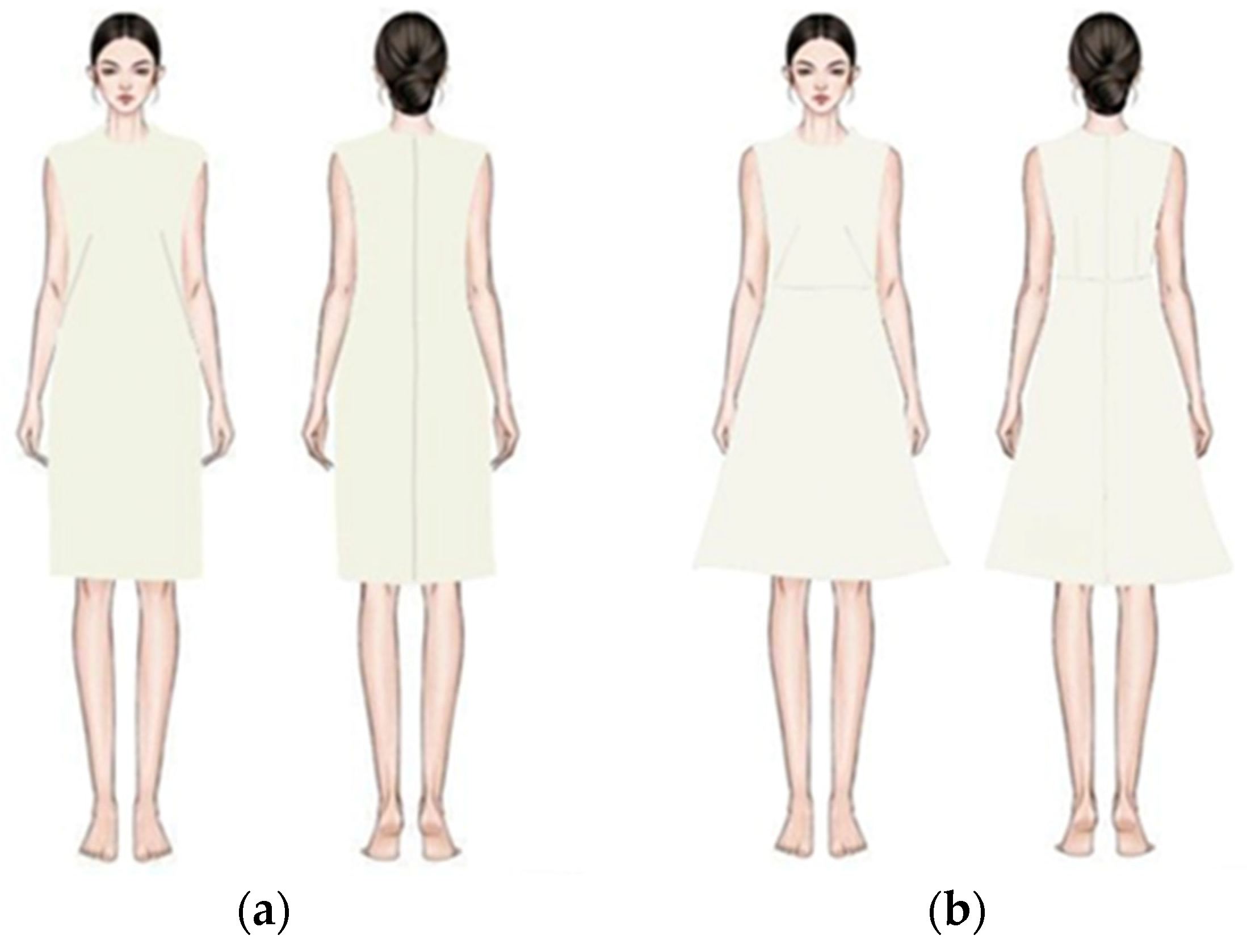
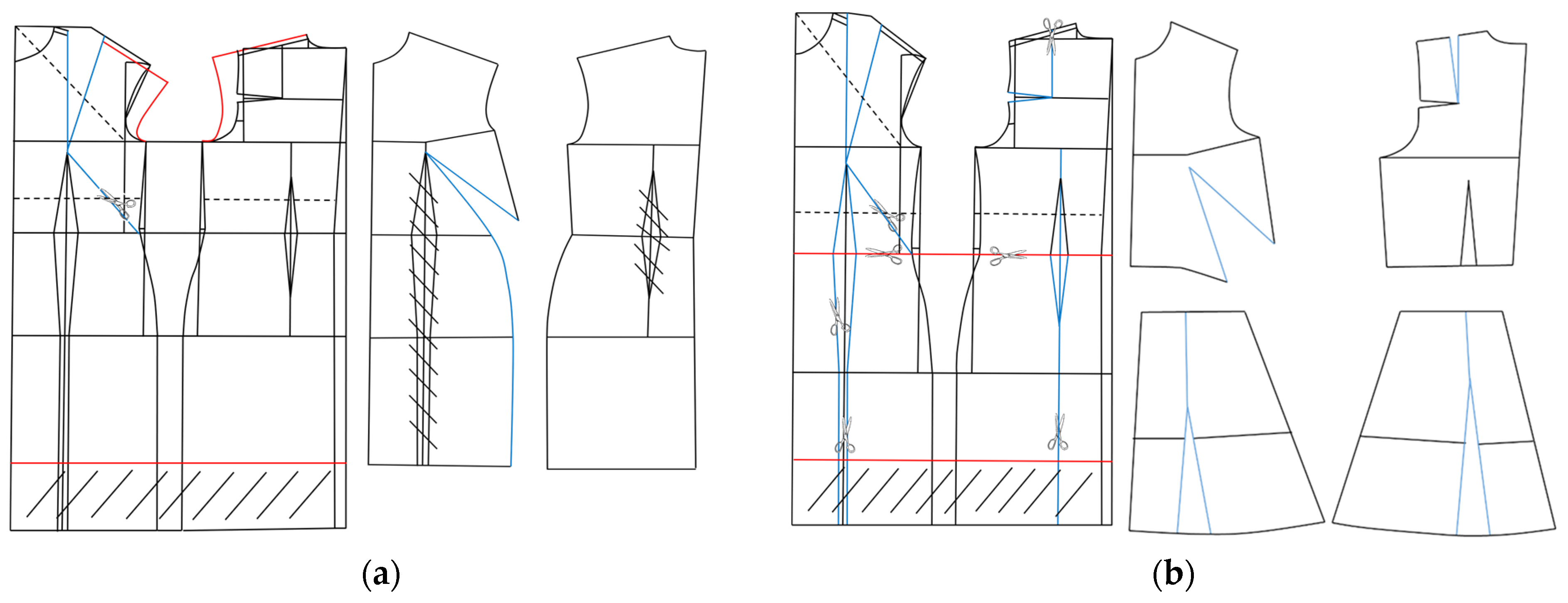

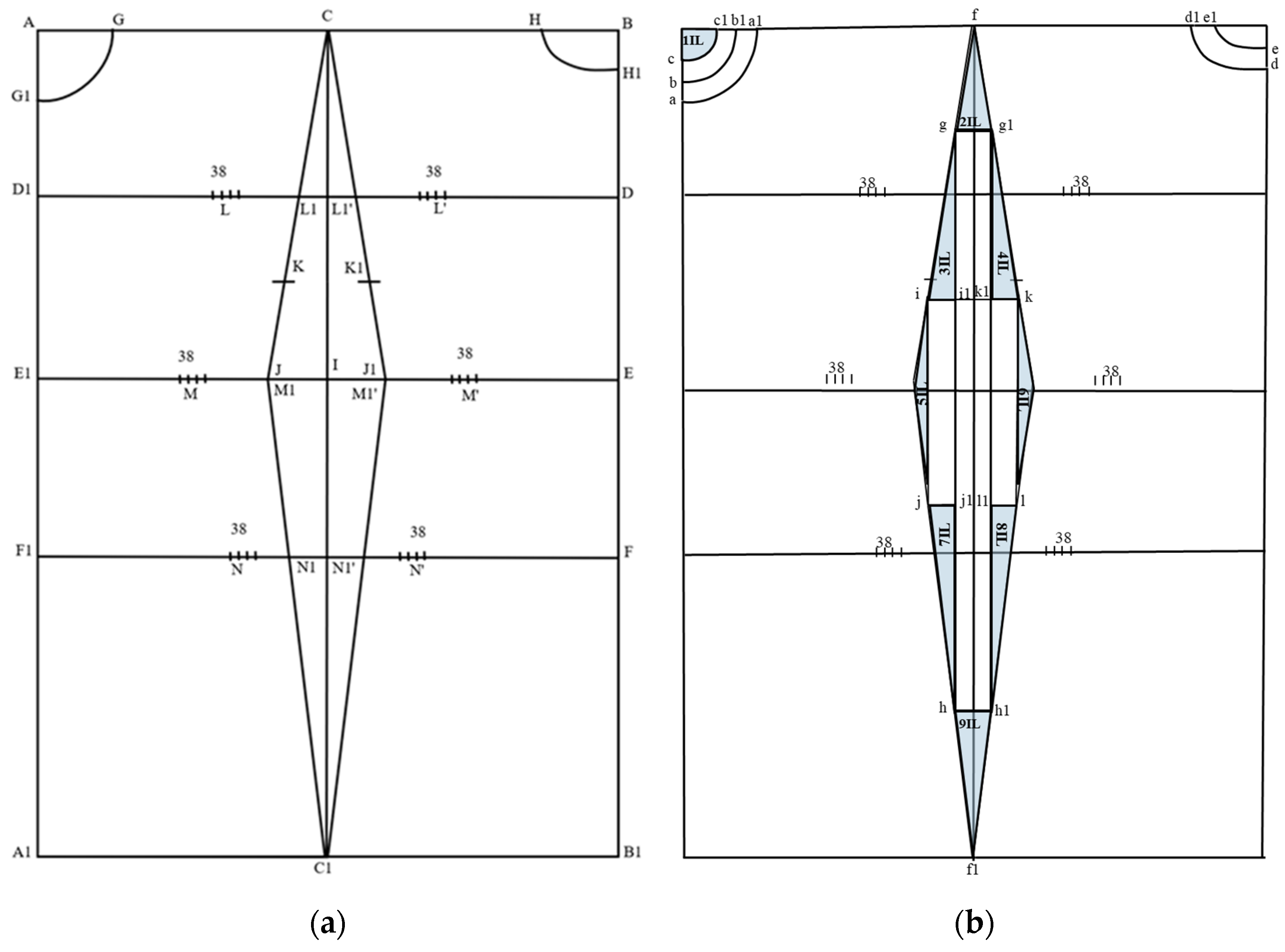
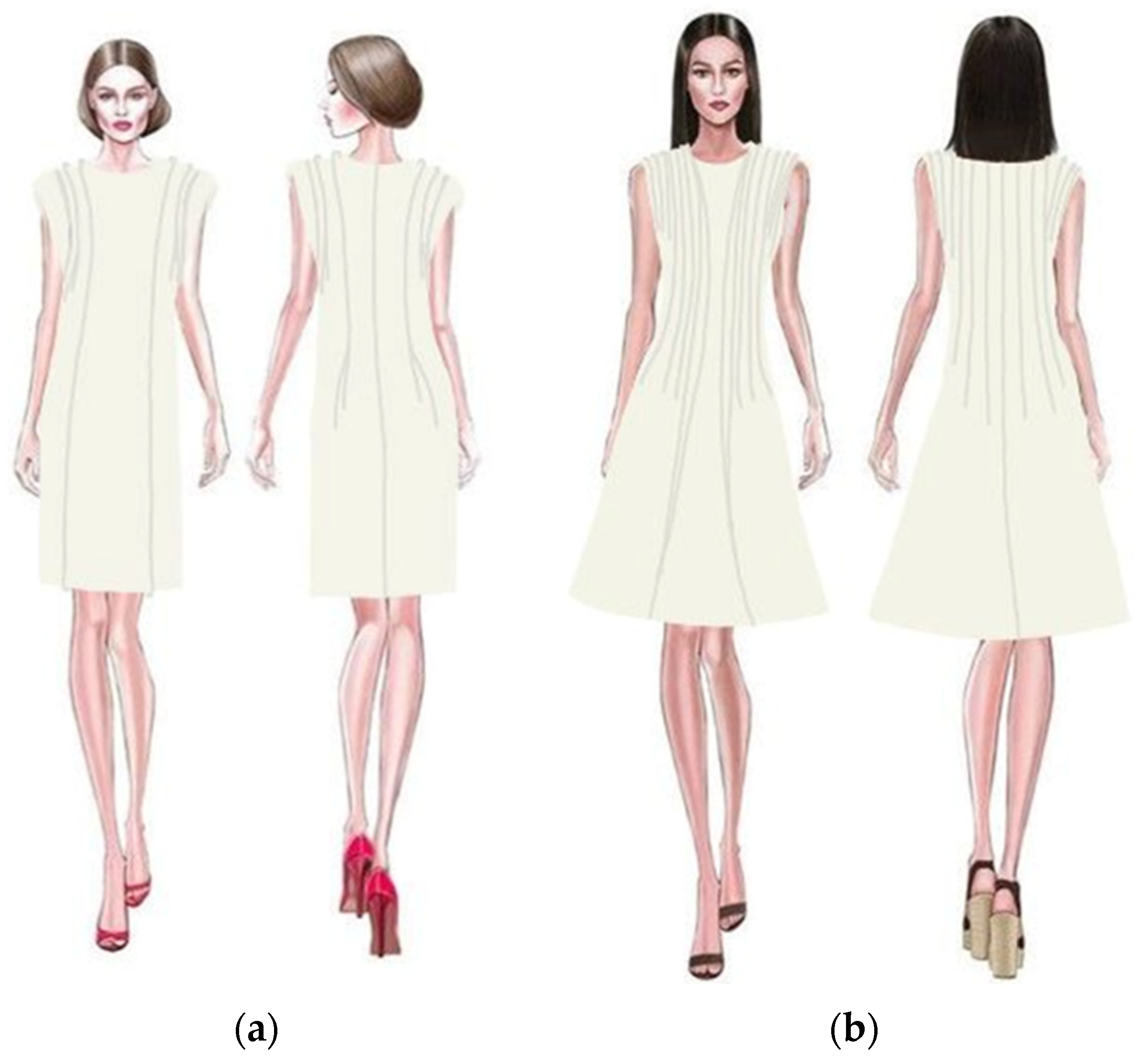
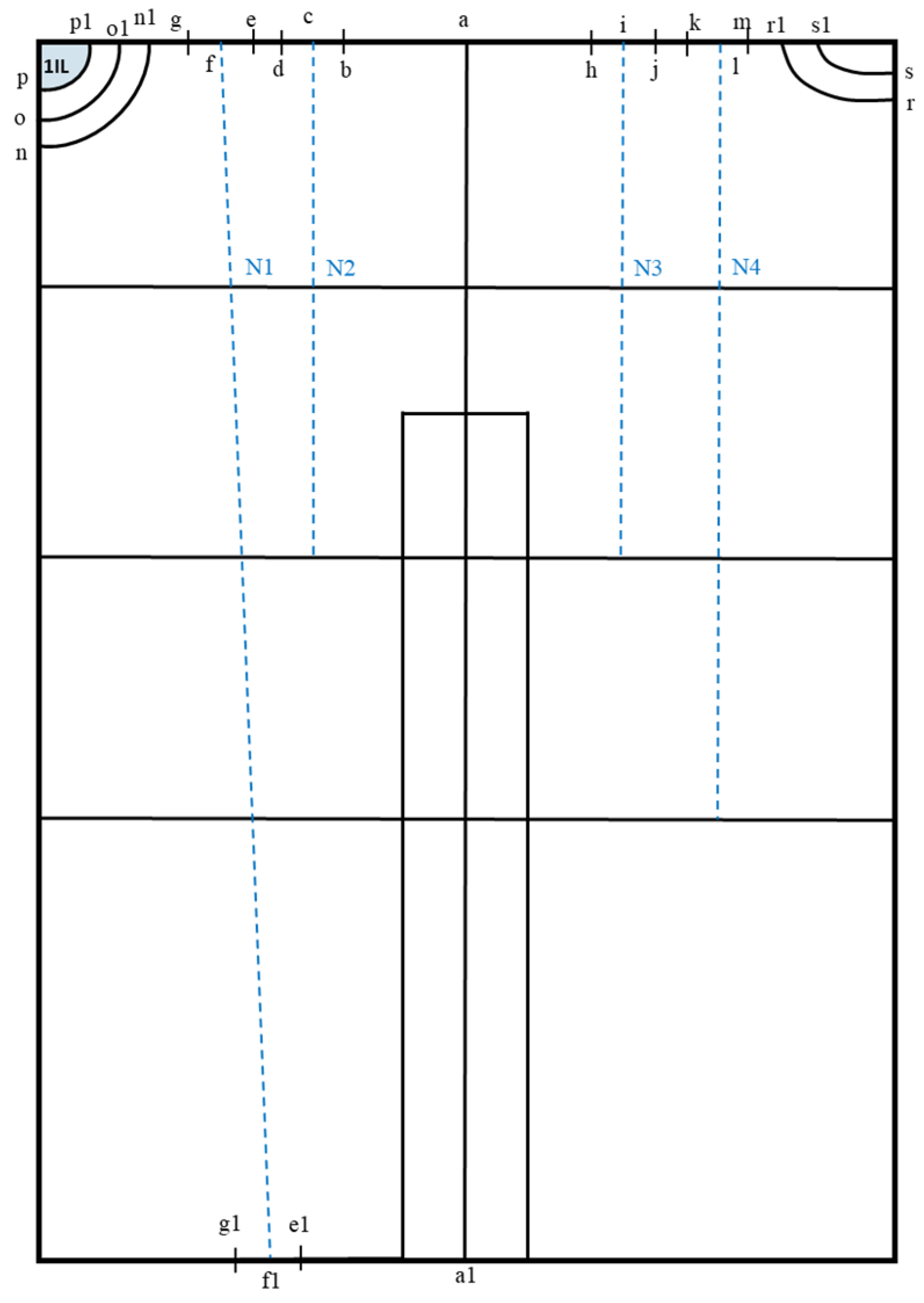
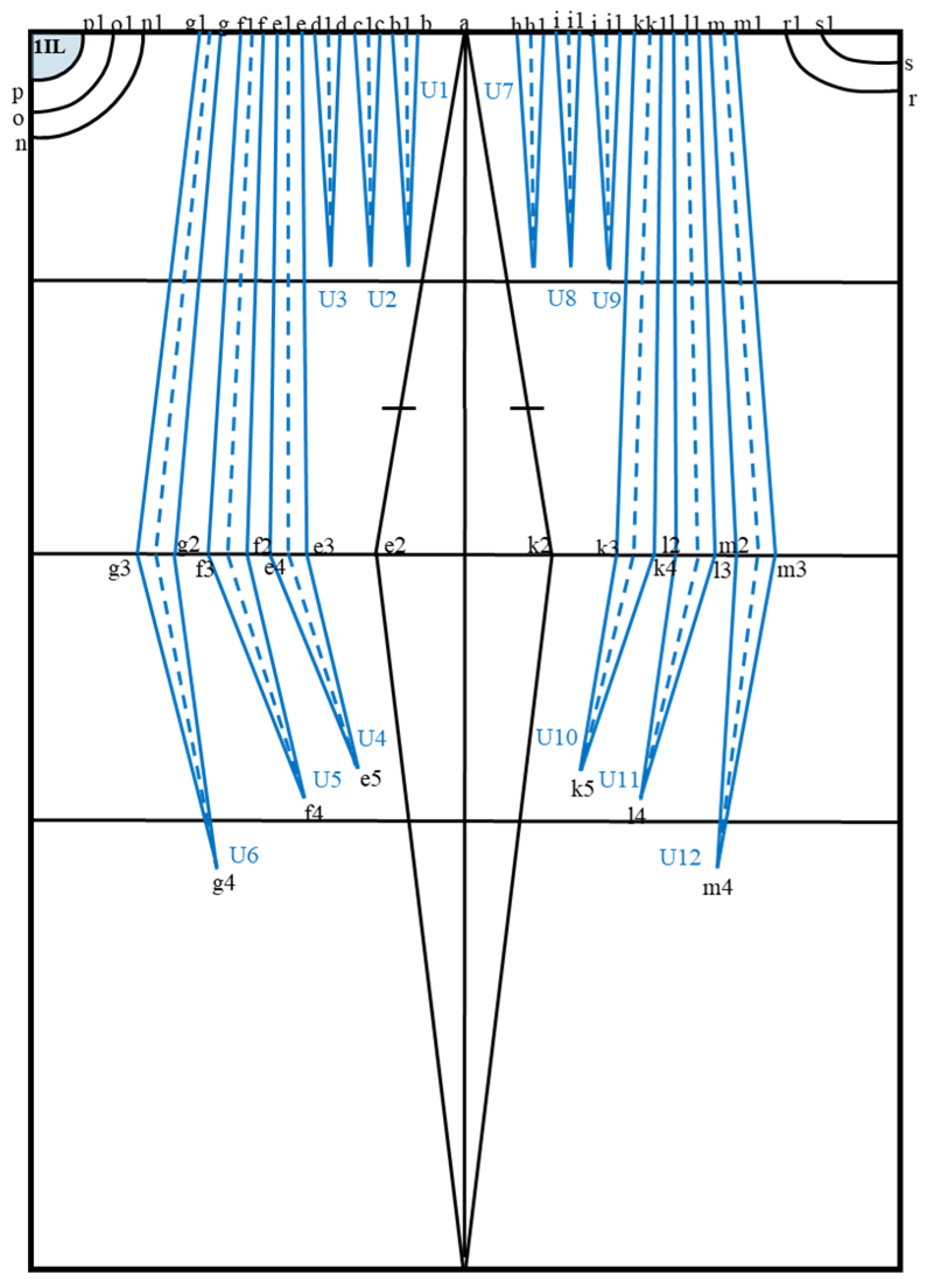
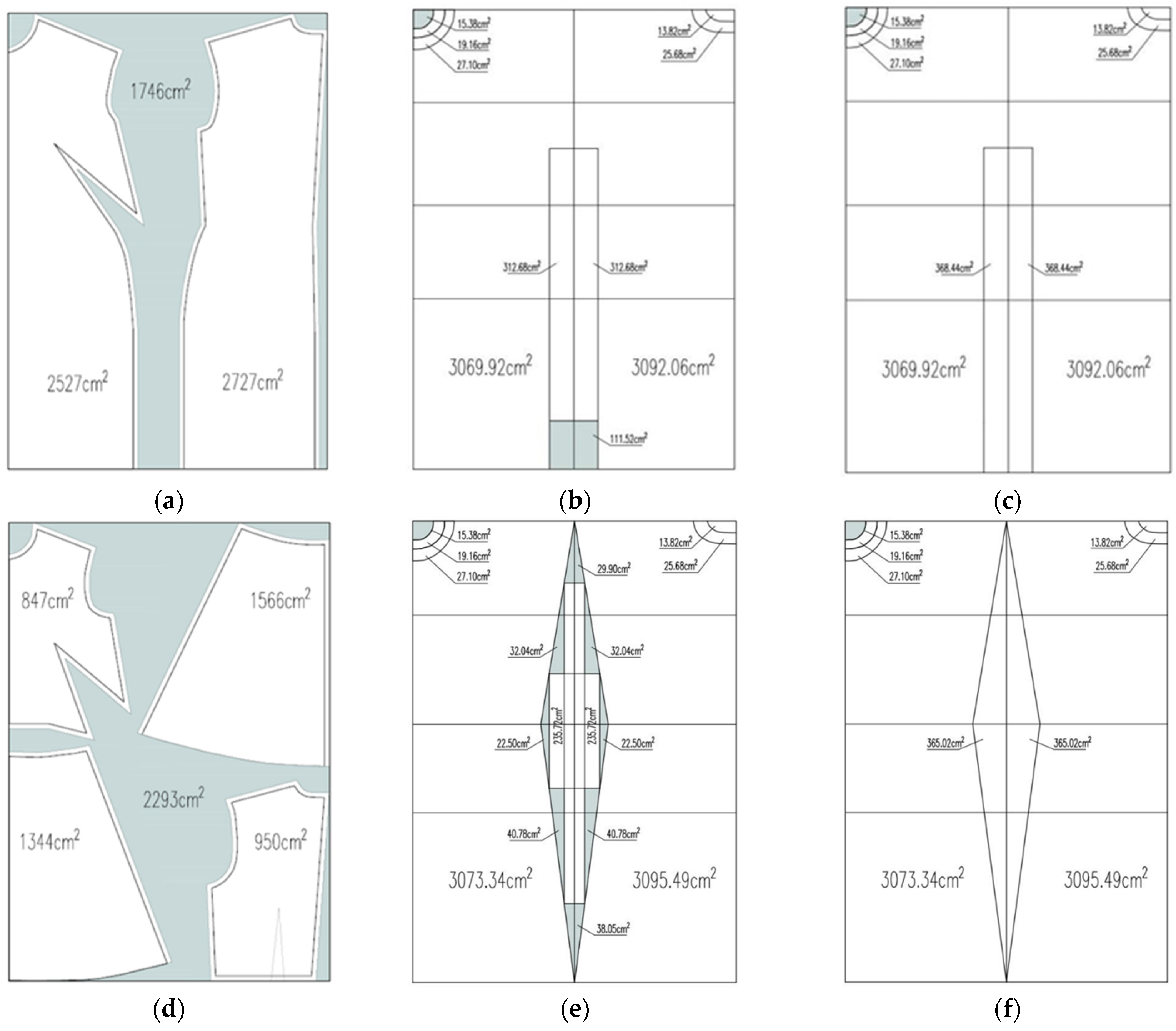
| Construction Measurements of the Basic Cut of a Women’s Dress | Amount of Construction Dimensions/cm | Construction Measures According to the TAXI Method | Amount of Construction Measure/cm |
|---|---|---|---|
| Sleeve depth (Sd) = 1/10 chest circumference + 10.5 cm (+1 cm add.) | 20.3 | Sleeve depth (Sd) = 1/10 chest circumference + 10.5 cm | 19.3 |
| Back length (Bl) = 1/4 height − 1 cm | 41 | Back length (Bl) = 1/4 height − 1 cm | 41 |
| Hip height (Hh) = 3/8 height | 63 | Hip height (Hh) = 3/8 height | 63 |
| Cut length (Cl) = 5/8 height | 105 | Cut length (Cl) = length of garment | 100 |
| data | Cut width (Cw) = half of the cut pattern | 70 | |
| Width of neckline (Wnl) = 1/20 chest circumference + 2 cm | 6.4 | Neckline width of the front part (Nlw Fp) = default | 9 |
| data | Back neck width (Blw) = default | 5 | |
| Cut length (Cl) = 5/8 height | 105 | Cut length (Cl) = length of garment Cut width (Cw) = half of the cut pattern | 100 |
| data | 70 | ||
| Front height (Fh) = back length + 1/20 chest circumference − 0.5 cm | 44.9 | No mathematical expression defined | - |
| Back width (Bw) = 1/8 chest circumference + 5.5 cm (+0.5 cm dod.) | 17 | Back width (Bw) = 1/4 chest circumference | 22 |
| Sleeve width (sW) = 1/8 chest circumference − 1.5 cm (+1.5 cm dod.) | 11 | Sleeve height (Sh) = default | 30 |
| Chest width (Cw) = 1/4 chest circumference − 4 cm (+1.5 cm dod.) | 19.5 | Chest width (Cw) = 1/4 chest circumference | 22 |
| Waist width (Ww) = 1/4 waist circumference − 1 cm | 17 | Waist width (Ww) = 1/4 waist circumference | 18 |
| Mathematical expression not defined | - | Hip width (Hw) = 1/4 hip circumference | 24 |
| Silhouette | IL-BCC/cm2 | IL-TM-BC/cm2 | IL-TM-DP/cm2 | Utilization BCC/% | Utilization TM-BC/% | Utilization TM-DP/% |
|---|---|---|---|---|---|---|
| “T” | 1746 | 126.9 | 15.38 | 75 | 98 | 99.8 |
| “X” | 2293 | 341.93 | 15.38 | 67.3 | 96 | 99.8 |
| Silhouette | IL-BCC/% | IL-TM-BC/% | IL-TM-DP/% |
|---|---|---|---|
| “T” | 25 | 2 | 0.2 |
| “X” | 32.7 | 4 | 0.2 |
Disclaimer/Publisher’s Note: The statements, opinions and data contained in all publications are solely those of the individual author(s) and contributor(s) and not of MDPI and/or the editor(s). MDPI and/or the editor(s) disclaim responsibility for any injury to people or property resulting from any ideas, methods, instructions or products referred to in the content. |
© 2025 by the authors. Licensee MDPI, Basel, Switzerland. This article is an open access article distributed under the terms and conditions of the Creative Commons Attribution (CC BY) license (https://creativecommons.org/licenses/by/4.0/).
Share and Cite
Karin, F.; Brlobašić Šajatović, B.; Šabarić Škugor, I. The TAXI Method: Reducing Fabric Waste with Recognizable Silhouettes in Sustainable Women’s Clothing. Sustainability 2025, 17, 698. https://doi.org/10.3390/su17020698
Karin F, Brlobašić Šajatović B, Šabarić Škugor I. The TAXI Method: Reducing Fabric Waste with Recognizable Silhouettes in Sustainable Women’s Clothing. Sustainability. 2025; 17(2):698. https://doi.org/10.3390/su17020698
Chicago/Turabian StyleKarin, Franka, Blaženka Brlobašić Šajatović, and Irena Šabarić Škugor. 2025. "The TAXI Method: Reducing Fabric Waste with Recognizable Silhouettes in Sustainable Women’s Clothing" Sustainability 17, no. 2: 698. https://doi.org/10.3390/su17020698
APA StyleKarin, F., Brlobašić Šajatović, B., & Šabarić Škugor, I. (2025). The TAXI Method: Reducing Fabric Waste with Recognizable Silhouettes in Sustainable Women’s Clothing. Sustainability, 17(2), 698. https://doi.org/10.3390/su17020698





